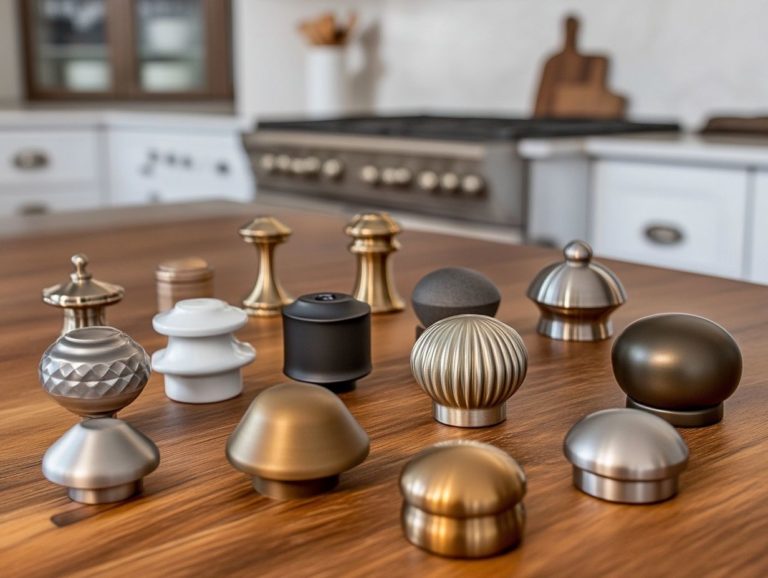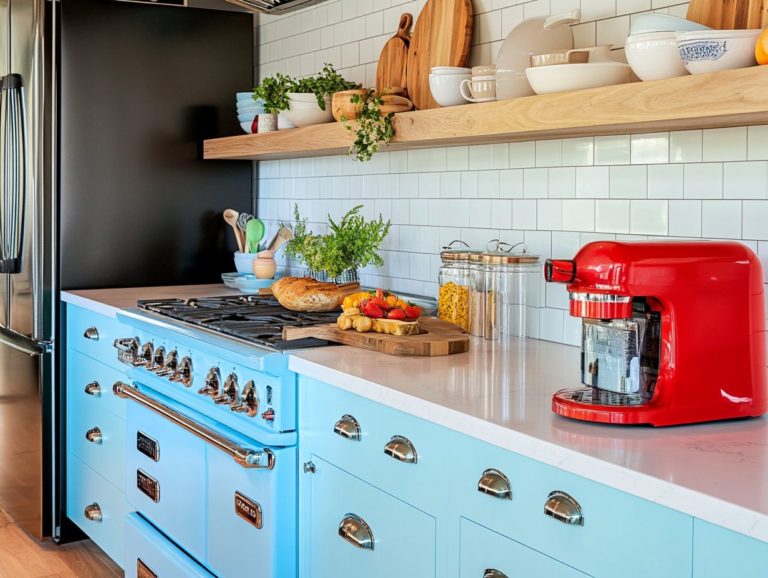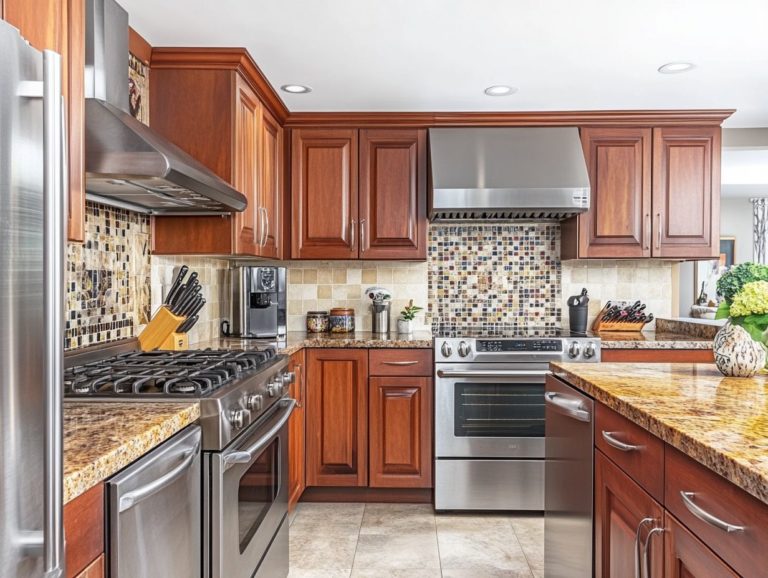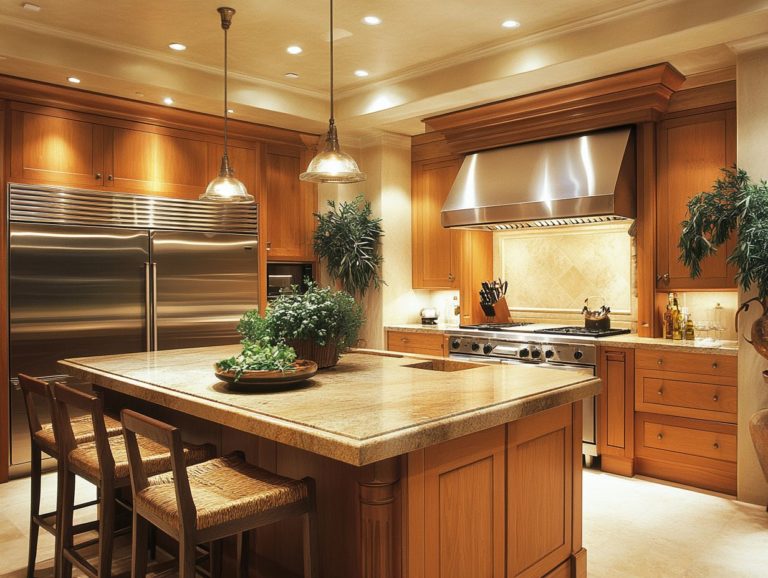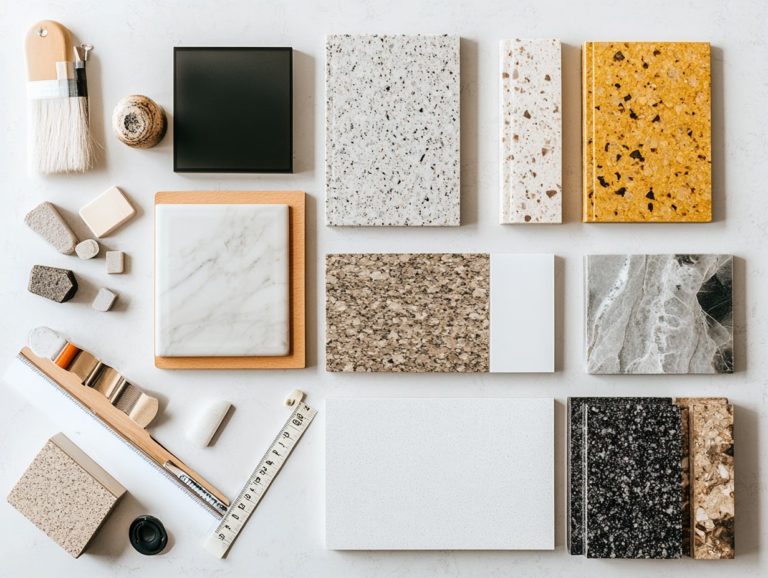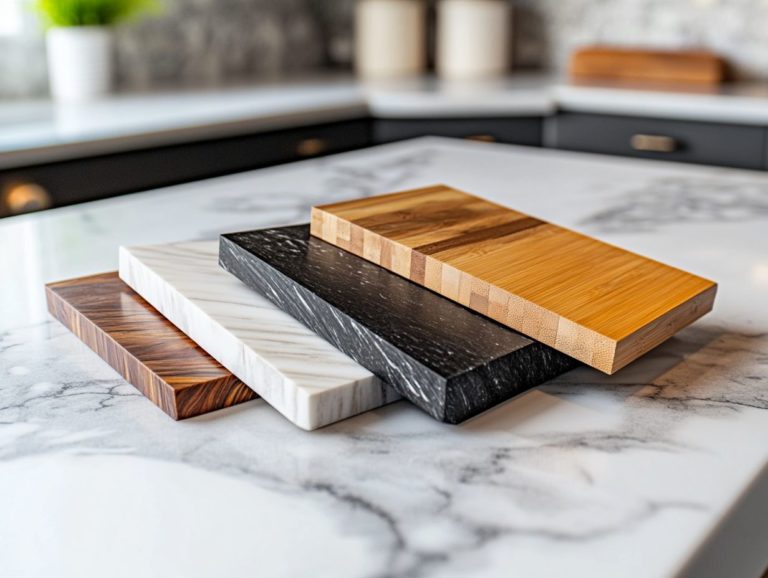Top 5 Durable Flooring Options for Your Kitchen
Choosing the right kitchen flooring is crucial—it sets the mood for your entire space! It’s not just about visual appeal; durability and ease of maintenance matter too.
With constant foot traffic, inevitable spills, and fluctuating temperatures, your flooring must endure the rigorous demands of a bustling kitchen.
This guide explores the top five durable flooring options: porcelain tile, laminate, vinyl plank, engineered hardwood, and natural stone.
You’ll discover the pros and cons of each type, along with comparisons of their durability, maintenance requirements, and average lifespans.
Whether you’re renovating or building a new kitchen, this information empowers you to make a well-informed decision.
Contents
- Key Takeaways:
- 1. Porcelain Tile
- 2. Laminate Flooring
- 3. Vinyl Plank Flooring
- 4. Engineered Hardwood
- 5. Natural Stone
- Factors to Consider When Choosing a Durable Flooring Option for Your Kitchen
- What Are the Benefits of Each Flooring Option?
- What Are the Drawbacks of Each Flooring Option?
- How Do These Flooring Options Compare in Terms of Durability and Maintenance?
- What Are the Recommended Cleaning and Maintenance Practices for Each Flooring Option?
- What Is the Average Lifespan of Each Flooring Option?
- Frequently Asked Questions
- What are the top 5 durable flooring options for my kitchen?
- What makes ceramic tile a durable flooring option for my kitchen?
- Is vinyl a good choice for a high-traffic kitchen?
- How does laminate flooring compare to hardwood flooring in terms of durability?
- What is the difference between hardwood and engineered wood flooring?
- Is it important to consider the level of foot traffic in my kitchen when choosing a durable flooring option?
Key Takeaways:
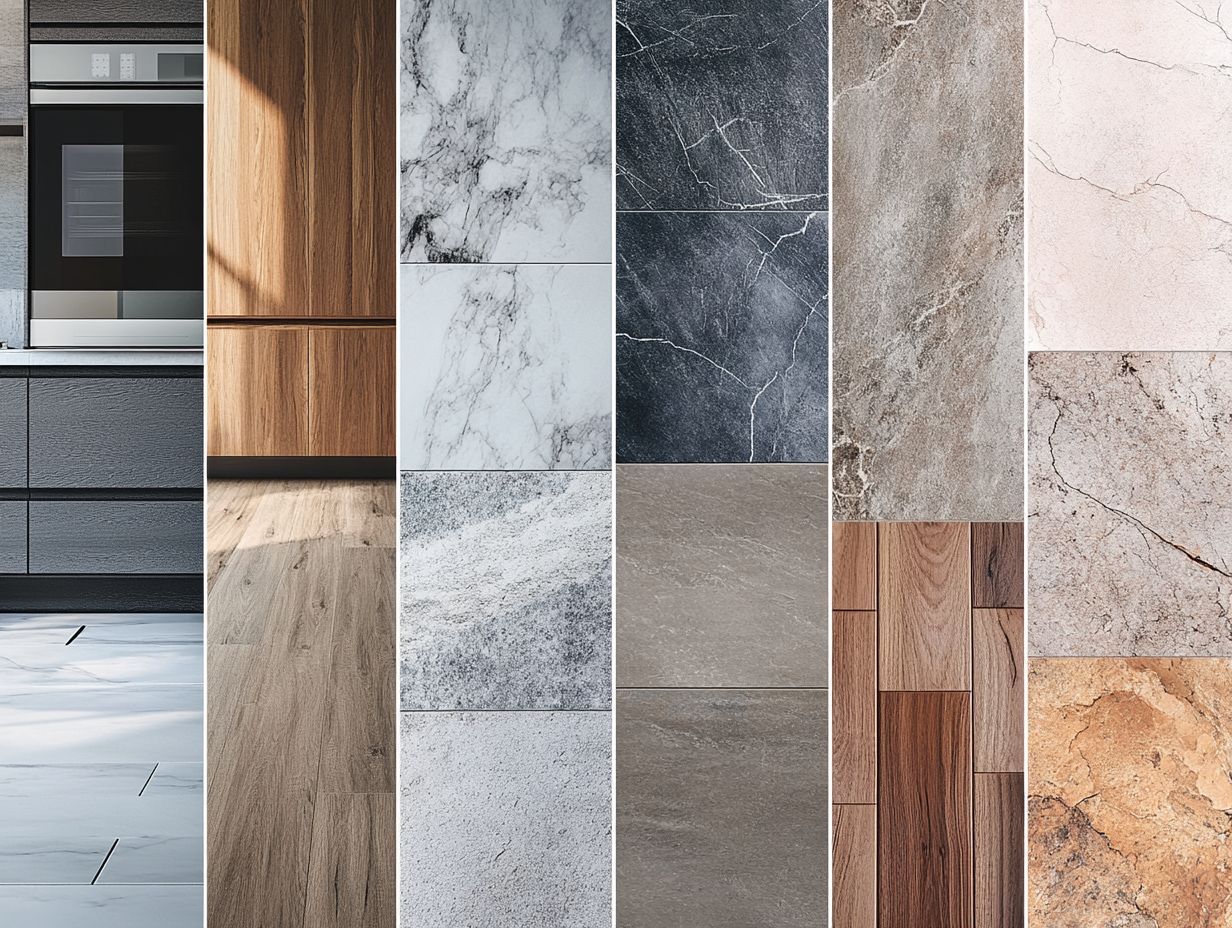
Consider factors like durability, maintenance, and lifespan when choosing a kitchen floor. Porcelain tile, laminate, vinyl, engineered hardwood, and natural stone are top durable flooring options. Each type has unique benefits and drawbacks, so weigh them carefully before deciding.
1. Porcelain Tile
Porcelain tile is an excellent choice for kitchen flooring. It combines durability, water resistance, and style that elevates your kitchen space.
Its designs and strong nature make porcelain particularly suited for high-traffic areas, providing a long-lasting floor that fits various kitchen styles.
Whether you prefer a sleek modern look or classic charm, porcelain tile meets diverse tastes while being easy to clean.
Porcelain tile offers many options, from glossy finishes for a contemporary vibe to textured surfaces that add warmth and character.
You can find patterns that mimic natural materials like wood or stone, achieving a beautiful aesthetic without the maintenance hassles.
When comparing porcelain tile with laminate or hardwood, its advantages become clear. It lasts longer and is less prone to scratches, dents, and moisture damage.
These features enhance visual appeal and promise lower maintenance costs with infrequent replacements. Investing in porcelain tile is a smart decision for homeowners wanting to enrich their kitchen environment.
2. Laminate Flooring
Laminate flooring has become a popular choice for many homeowners, and it’s easy to see why. It’s affordable and can mimic the look of hardwood or tile, making it perfect for stylish kitchen remodels.
Laminate flooring is easy to install, often requiring no special tools—this is a significant advantage over traditional hardwood and tile.
With a wide range of designs, colors, and textures, your flooring can seamlessly complement any decor. Unlike hardwood, which scratches and needs regular refinishing, laminate is resistant to wear and tear, making it a low-maintenance alternative.
Moreover, it handles moisture better than tile, making it a practical choice for kitchens and bathrooms.
3. Vinyl Plank Flooring
Vinyl plank flooring stands out as a superb choice for your kitchen, blending water resistance and comfort with stylish designs that elevate your kitchen’s look.
This option allows you to achieve a high-end aesthetic without the steep price tag of natural wood or stone.
Its user-friendly installation appeals to DIY enthusiasts who enjoy home improvement projects.
Compared to laminate and porcelain tiles, vinyl plank offers a softer feel underfoot and excellent moisture resistance, significantly reducing warping or damage risks.
Maintenance is simple; regular sweeping and occasional mopping keep it looking pristine, proving that durability thrives alongside style.
4. Engineered Hardwood
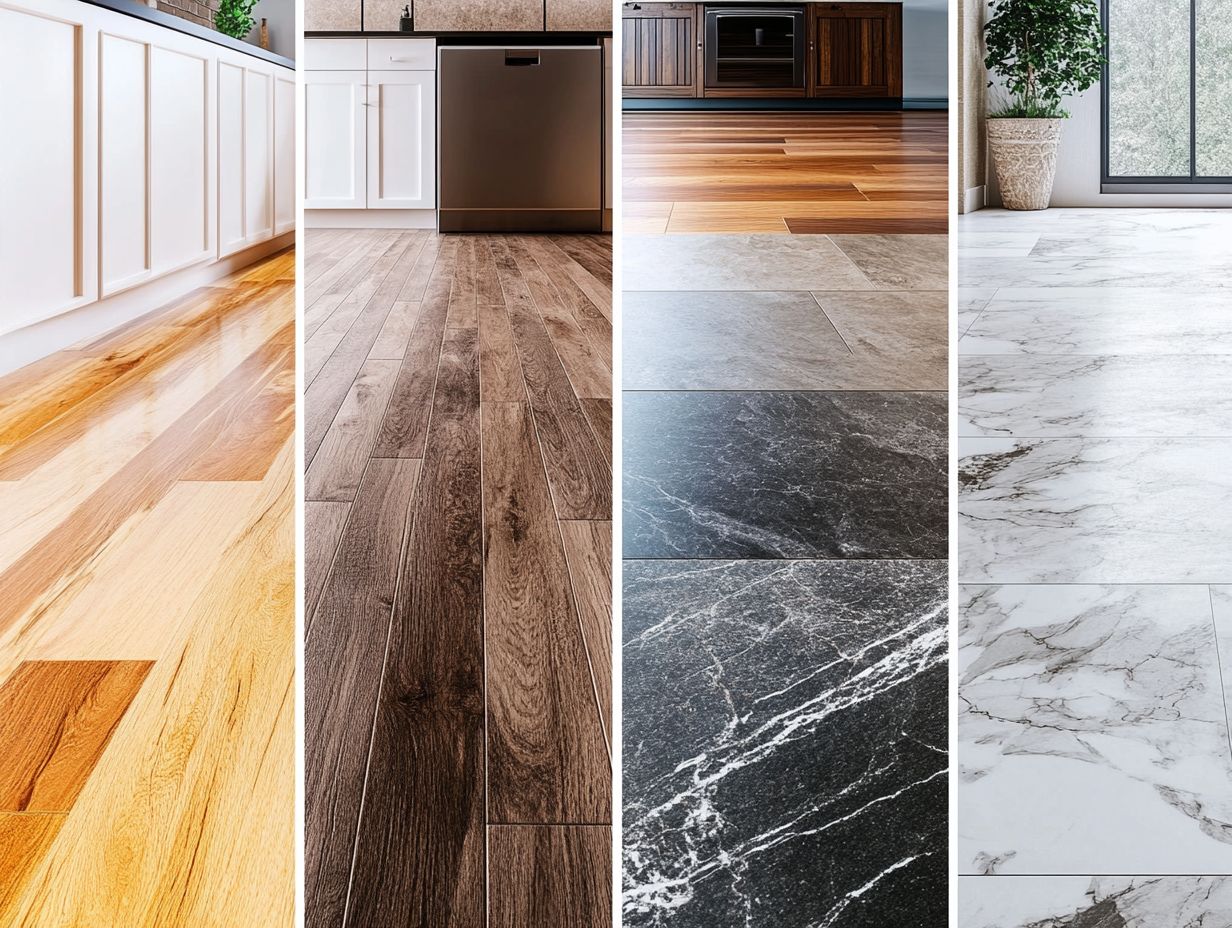
Engineered hardwood offers a luxurious blend of style and durability, making it a top-tier choice for your kitchen flooring. Here, the timeless elegance of traditional hardwood meets modern technology, ensuring it withstands the rigors of everyday life.
Unlike solid hardwood, which comes from a single piece of timber, engineered hardwood is wood made from several layers of thinner wood glued together. This design provides exceptional stability and resistance to humidity fluctuations, ensuring that your floors remain beautiful and functional.
The top layer is typically a high-quality hardwood, delivering the classic look that many homeowners covet. You’ll find that engineered hardwood is often easier to install than traditional options. It can be floated over concrete or existing floors, eliminating the hassle of nails or glue.
Aesthetically, you’ll be pleased with the wide array of finishes and styles available, allowing for seamless integration into your décor. Maintenance is a breeze as well; these floors are generally more resistant to scratches and can be cleaned with minimal effort, striking that perfect balance between beauty and practicality.
5. Natural Stone
Imagine transforming your kitchen with the timeless elegance of natural stone flooring! Natural stone, like granite or slate, adds unparalleled aesthetics and durability, making it an ideal choice for anyone looking to elevate their kitchen remodel.
Among the many options, each type of natural stone reveals unique characteristics that distinguish it from the rest. For example, marble is renowned for its luxurious veining and visual appeal, but it demands more maintenance to keep it from staining.
Slate stands out for its durability and slip resistance, making it the go-to option for practical designs. When weighing costs, remember to factor in both the price of the materials and the expenses associated with professional installation, which can vary significantly based on the complexity of the job.
Regular sealing and proper cleaning practices are crucial for preserving the stone’s beauty over time. Don’t miss your chance to elevate your kitchen with stunning natural stone!
Factors to Consider When Choosing a Durable Flooring Option for Your Kitchen
When choosing the perfect flooring for your kitchen, several factors come into play: durability, water resistance, maintenance needs, aesthetics, and cost. Each of these elements is crucial to ensure your flooring choice meets both practical requirements and design aspirations.
Understanding how these factors interact with various materials can truly elevate your kitchen experience. For example, hardwood brings a timeless beauty and warmth to the space, but it may struggle with water resistance, making it less suitable for households prone to spills.
Porcelain tile shines in durability and moisture resistance, making it an ideal choice for modern, sleek kitchens that favor a minimalist aesthetic. Luxury vinyl planks strike a delightful balance, offering the look of wood or stone while being easier to maintain and more budget-friendly.
Ultimately, your decision should resonate with your kitchen’s style—whether it embodies farmhouse charm, industrial sleekness, or contemporary minimalism—ensuring a harmonious blend of functionality and visual appeal.
What Are the Benefits of Each Flooring Option?
Each flooring option presents distinct benefits tailored to various kitchen environments, underscoring the significance of choosing the right type for optimal functionality, aesthetics, and ease of maintenance.
- Durability: Materials like tile and luxury vinyl can handle heavy foot traffic and resist scratches, ensuring they maintain their appeal over time.
- Water Resistance: Especially in kitchens prone to spills, laminate and vinyl floors effectively prevent moisture damage and warping.
- Ease of Maintenance: Choices like porcelain tile and sealed hardwood offer a hassle-free cleaning experience, allowing you to enjoy your kitchen without the burden of constant upkeep.
By considering these factors, you can craft a stylish yet practical kitchen environment that meets your needs.
What Are the Drawbacks of Each Flooring Option?
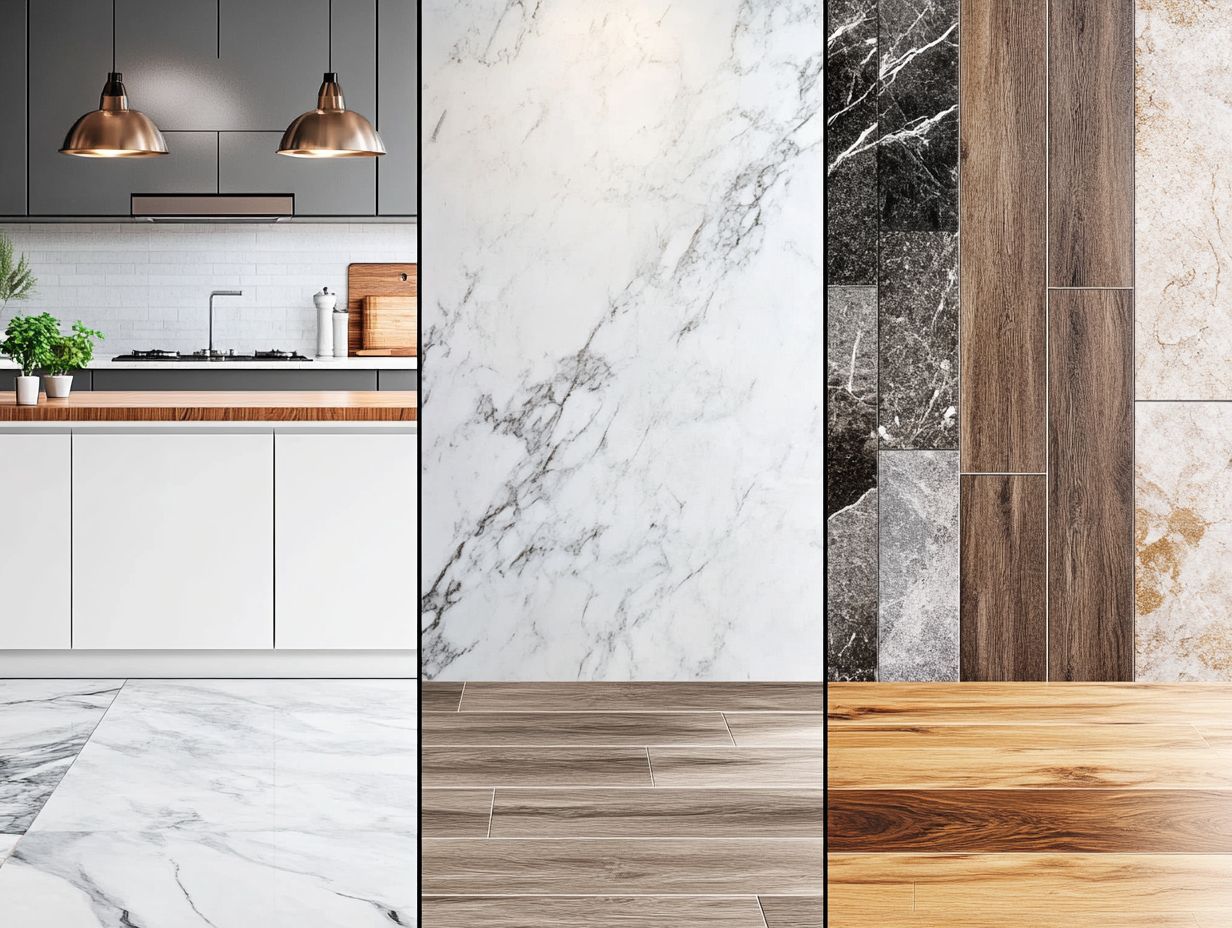
While each flooring option offers its unique set of advantages, it is crucial to recognize the drawbacks that can arise during your renovation journey. Recognizing these drawbacks helps you avoid costly mistakes.
Some materials require more maintenance than others, potentially increasing your costs over time. Others might be more susceptible to scratches, dents, or water damage, making them less than ideal for a bustling kitchen environment.
Additionally, some flooring types require a steep initial investment, which can stretch your overall kitchen remodel budget. By carefully weighing these factors, you can ensure that your flooring choice enhances your design vision while aligning with your long-term maintenance needs and financial goals.
How Do These Flooring Options Compare in Terms of Durability and Maintenance?
When choosing the ideal flooring for your kitchen, it’s vital to compare the durability and maintenance of various options, as these factors directly impact both longevity and appearance.
With choices ranging from hardwood to tile, understanding how each material compares is essential for making a savvy investment. Hardwood has a timeless look. However, it requires more maintenance and refinishing over the years.
In contrast, ceramic tile is renowned for its durability and ease of cleaning, making it a top pick for high-traffic areas. Vinyl planks also present a compelling option, offering resilience against scratches and moisture while remaining relatively low maintenance.
To help you visualize these differences, here’s a quick comparison:
- Hardwood: Durable but requires regular maintenance; susceptible to water damage.
- Ceramic Tile: Extremely durable; easy to clean, though it can feel cold and hard underfoot.
- Vinyl: Highly resilient; low maintenance and water-resistant, perfect for families.
- Laminate: Budget-friendly and scratch-resistant; however, it may not last as long as other options.
Each material has its distinct advantages and disadvantages, making it crucial for you to assess your personal needs and preferences when selecting the right flooring for your kitchen.
What Are the Recommended Cleaning and Maintenance Practices for Each Flooring Option?
Understanding the recommended cleaning and maintenance practices for each flooring option is crucial for preserving their appearance and functionality in a bustling kitchen environment.
By implementing specific routines tailored to materials like tile, hardwood, or laminate, you can ensure that your spaces remain not only visually appealing but also safe and hygienic.
For example, using a gentle cleaner that won’t harm surfaces for tile helps eliminate grime without harming the grout lines, while a microfiber mop is perfect for capturing dirt on hardwood floors without scratching their surface.
Recognizing the need for regular sweeping or vacuuming, perhaps daily in high-traffic areas, will prevent debris from accumulating and causing lasting damage.
By adhering to these practices, you enhance the longevity of your flooring and contribute to a pleasant and welcoming atmosphere in your kitchen.
What Is the Average Lifespan of Each Flooring Option?
The average lifespan of flooring options varies significantly, which can greatly influence your decisions as a homeowner, particularly when considering durability and long-term value for your kitchen remodel.
For example, hardwood floors can last anywhere from 20 to 100 years, depending on how well you maintain them and the quality of the materials you choose. Laminate usually lasts about 15 to 25 years. Tile and vinyl floors can enjoy lifespans of 20 to 40 years, provided they’re installed properly and cared for.
These differences often lead you to weigh the advantages of investing in higher-end materials against your budget constraints. Knowing the average lifespan of your flooring can save you money in the long run!
Frequently Asked Questions
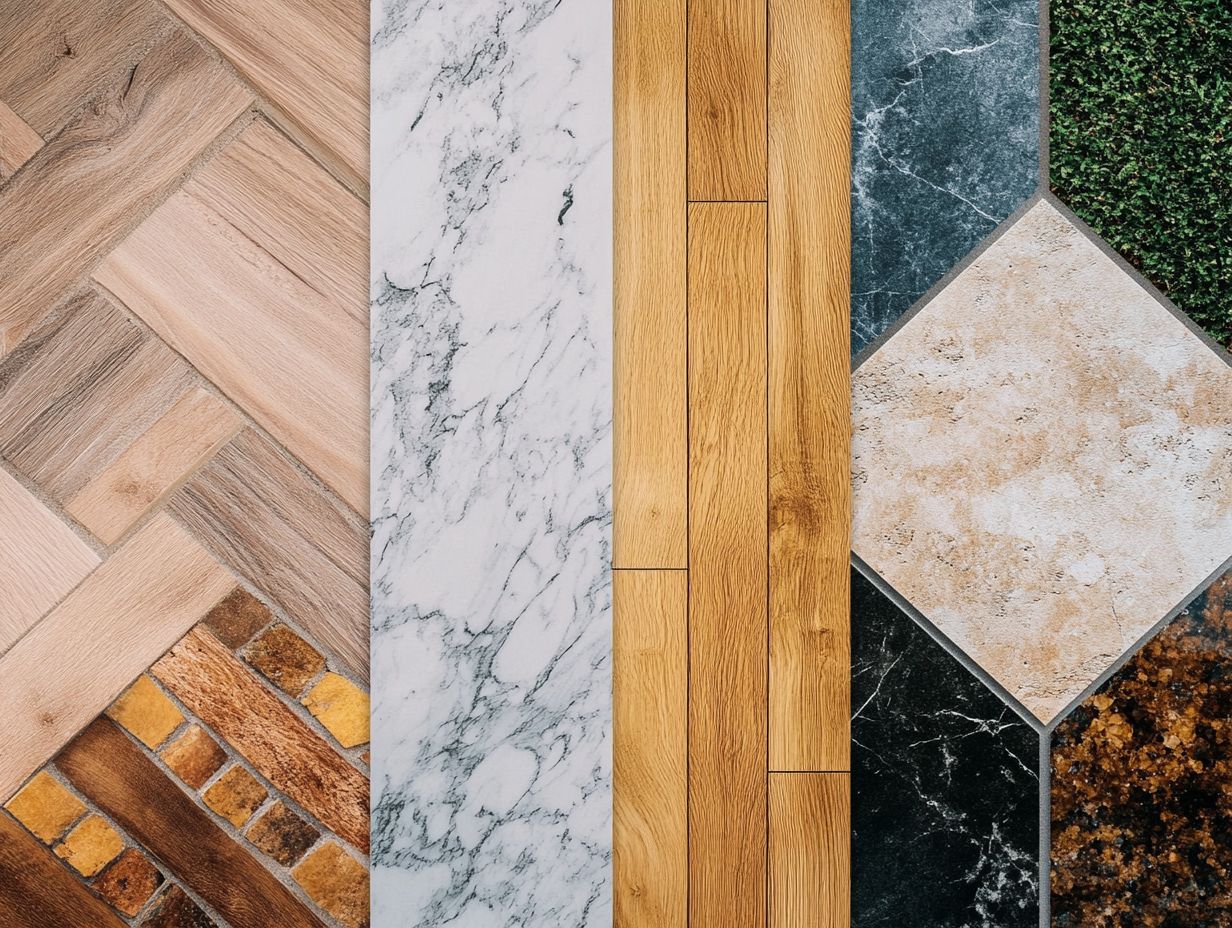
What are the top 5 durable flooring options for my kitchen?
- Ceramic tile
- Vinyl
- Laminate
- Hardwood
- Engineered wood
What makes ceramic tile a durable flooring option for my kitchen?
Ceramic tile resists stains, scratches, and water. It’s easy to clean, making it perfect for a busy kitchen.
Is vinyl a good choice for a high-traffic kitchen?
Absolutely! Vinyl combines style and durability for your busy kitchen. It’s water-resistant and easy to clean, available in many styles.
How does laminate flooring compare to hardwood flooring in terms of durability?
Laminate flooring offers a cost-effective alternative to hardwood. It resists scratches, stains, and moisture, making it a smart choice for kitchens.
What is the difference between hardwood and engineered wood flooring?
Hardwood is made from solid wood planks. Engineered wood features a thin layer of hardwood on top of plywood layers, providing better resistance to humidity.
Is it important to consider the level of foot traffic in my kitchen when choosing a durable flooring option?
Yes, foot traffic matters! For busy kitchens, opt for durable options like ceramic tile or vinyl. If foot traffic is lower, you can choose from a wider range of materials.
